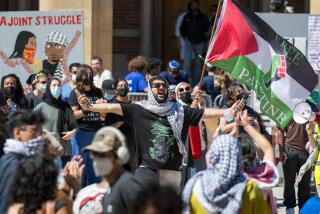UC Davis’ pepper spray fallout
- Share via
Anybody who watched last fall’s viral videos of campus police officers blasting orange pepper spray into the faces of seated protesters at UC Davis could have figured out that something had gone very wrong on the Central California campus. But it took two reports on the incident by an independent university panel and paid consultants to spell out the scope of the screw-ups, which indict not just the officers holding the spray canisters but the entire campus police force, its chief, a team of university leaders and Chancellor Linda Katehi. Disciplinary action should be next.
Campus police claimed their harsh response was justified because they were surrounded by a hostile crowd and needed to use pepper spray to clear a path out of the quad. Investigation by Kroll Inc., a New York-based risk consultancy headed by former L.A. Police Chief William Bratton, found little support for that conclusion; officers were able to walk freely through the crowd to take arrestees to squad cars or talk with a backup contingent from the Davis Police Department. What’s more, Lt. John Pike, whose injudicious use of the painful spray turned him into an Internet meme, was improperly using a powerful type of spray canister that wasn’t authorized under department guidelines and that he wasn’t trained to use.
It only gets worse from there. University officials had ample warning that protesters might set up a tent city in the quad, yet preparation was haphazard. Communication from leaders was poor or nonexistent — Katehi didn’t make it clear to Police Chief Annette Spicuzza that she didn’t want officers to use force, and Spicuzza, who didn’t attend the operational briefing before the incident, had little control over her lieutenants, who refused to follow her orders. The decision to roust protesters in the afternoon rather than the middle of the night as previously planned increased the risk of confrontation, and it’s not even clear whether the police had any legal justification for arresting protesters or removing their tents. Police didn’t follow state or national rules on incident planning and made glaring procedural mistakes such as failing to plan for the transport of arrestees.
Law-and-order types were quick to give police the benefit of the doubt in the wake of the protest, with celebrated author Joseph Wambaugh even suggesting in a Times Op-Ed that the university save the cost of Kroll’s services and simply chalk up the mess to tired officers confronting spoiled students. Yet the reports by Kroll and the university are a valuable portrait of a campus police department in severe disarray. Those most responsible — Pike, Spicuzza and an unidentified officer — have been placed on paid administrative leave during the investigation; demotions or other disciplinary measures would be justified.
More to Read
A cure for the common opinion
Get thought-provoking perspectives with our weekly newsletter.
You may occasionally receive promotional content from the Los Angeles Times.






